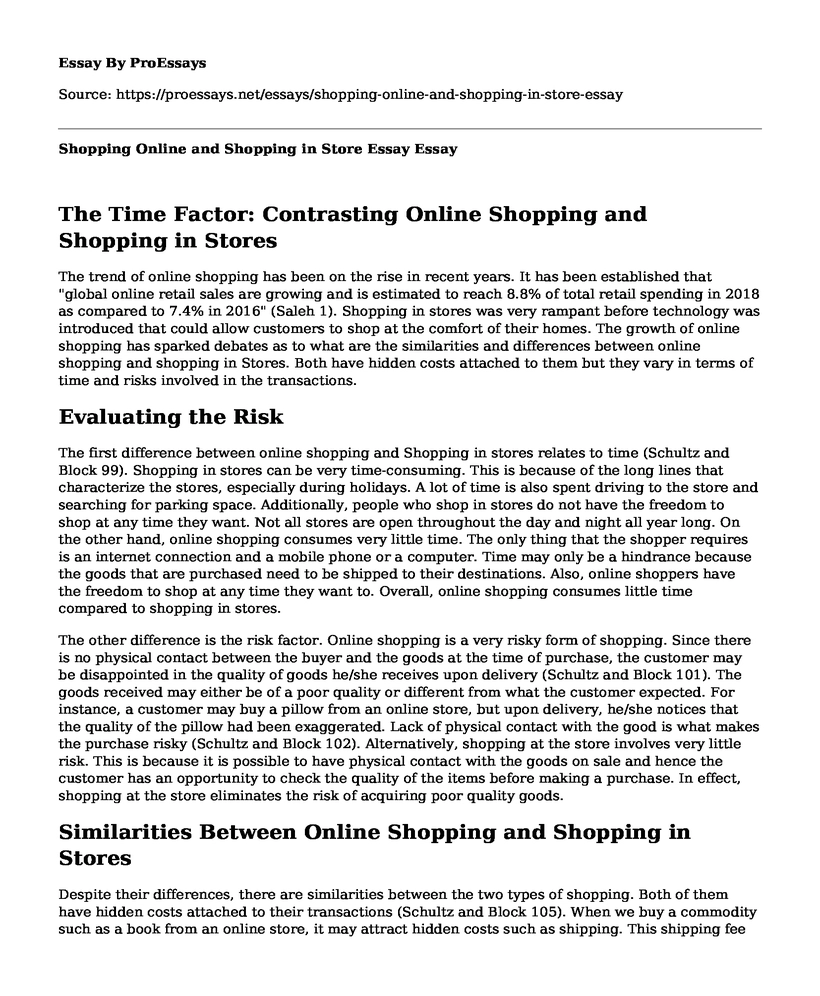The Time Factor: Contrasting Online Shopping and Shopping in Stores
The trend of online shopping has been on the rise in recent years. It has been established that "global online retail sales are growing and is estimated to reach 8.8% of total retail spending in 2018 as compared to 7.4% in 2016" (Saleh 1). Shopping in stores was very rampant before technology was introduced that could allow customers to shop at the comfort of their homes. The growth of online shopping has sparked debates as to what are the similarities and differences between online shopping and shopping in Stores. Both have hidden costs attached to them but they vary in terms of time and risks involved in the transactions.
Evaluating the Risk
The first difference between online shopping and Shopping in stores relates to time (Schultz and Block 99). Shopping in stores can be very time-consuming. This is because of the long lines that characterize the stores, especially during holidays. A lot of time is also spent driving to the store and searching for parking space. Additionally, people who shop in stores do not have the freedom to shop at any time they want. Not all stores are open throughout the day and night all year long. On the other hand, online shopping consumes very little time. The only thing that the shopper requires is an internet connection and a mobile phone or a computer. Time may only be a hindrance because the goods that are purchased need to be shipped to their destinations. Also, online shoppers have the freedom to shop at any time they want to. Overall, online shopping consumes little time compared to shopping in stores.
The other difference is the risk factor. Online shopping is a very risky form of shopping. Since there is no physical contact between the buyer and the goods at the time of purchase, the customer may be disappointed in the quality of goods he/she receives upon delivery (Schultz and Block 101). The goods received may either be of a poor quality or different from what the customer expected. For instance, a customer may buy a pillow from an online store, but upon delivery, he/she notices that the quality of the pillow had been exaggerated. Lack of physical contact with the good is what makes the purchase risky (Schultz and Block 102). Alternatively, shopping at the store involves very little risk. This is because it is possible to have physical contact with the goods on sale and hence the customer has an opportunity to check the quality of the items before making a purchase. In effect, shopping at the store eliminates the risk of acquiring poor quality goods.
Similarities Between Online Shopping and Shopping in Stores
Despite their differences, there are similarities between the two types of shopping. Both of them have hidden costs attached to their transactions (Schultz and Block 105). When we buy a commodity such as a book from an online store, it may attract hidden costs such as shipping. This shipping fee is paid separately from the purchase price of the item and is charged depending on the distance to the destination. Concurrently, shopping at the store also attracts very many hidden costs. The item attracts the cost of storage which is added to the overall price of the product. Furthermore, goods purchased at the store attract Value Added Tax (VAT) which increases the overall price of the item by a considerable margin. For instance, buying a book from a bookstore attracts the hidden costs of the VAT, storage costs, and transportation costs among others. Therefore, both online shopping and shopping at the store attract a variety of hidden costs.
Conclusion
Evidently, time and risks are both factors that distinguish online shopping and shopping in stores. Shopping in stores can be time-consuming because an individual has to visit the store physically while online stores save time because shopping can be done from an unspecified place. Online shopping is also riskier because of lack of physical contact at the time of purchase. However, it is also reasonable to argue that both have hidden costs such as storage charges attached to them. This topic is crucial to the society because it helps the consumers to gauge how they could get the maximum out of their time and financial resources. Overall, I believe the time factor is what makes online shopping more popular than shopping in stores.
Works Cited
Saleh, Khalid. "Global Online Retail Spending - Statistics and Trends [Infographic]." Invesp - Conversion Rate Optimization Experts, www.invespcro.com/blog/global-online-retail-spending-statistics-and-trends/.
Schultz, Don E., and Martin P. Block. "US online shopping: Facts, fiction, hopes, and dreams." Journal of Retailing and Consumer Services 23 (2015): 99-106.
Cite this page
Shopping Online and Shopping in Store Essay. (2022, May 17). Retrieved from https://proessays.net/essays/shopping-online-and-shopping-in-store-essay
If you are the original author of this essay and no longer wish to have it published on the ProEssays website, please click below to request its removal:
- BRL Hardy Company Reengineering Essay
- Essay on Fight Club - The Consumerism and Capitalism Culture
- Essay Sample on Multi-Agent Systems: Agent-Based Modelling and Simulation
- Essay Example on Corporate Personhood: Legal Notion of Separate Entity
- Paper Example on Failing to Meet Customer Expectations: The Consequence of Poor Service
- ICT Revolution: Benefits and Risks for Organizations - Essay Sample
- Essay Sample on Gaining a Sustainable Competitive Advantage: A Comparison of Under Armour and Nike







